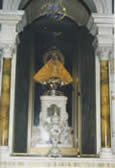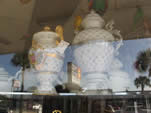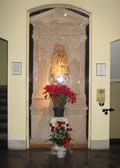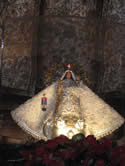
Enshrined image of the Virgin of Charity at the Sanctuary of El Cobre, 1997.
   
Virgin icon with sopera-like porcelain urn (left), El Cobre; soperas in botánica window, Miami (middle); handcarved replica in Washinton Heights church, NY City, 1929 (middle right); modern replica in Miami hemitage (right). Click on images to view full-size.
|
 |
< 5 >
The small doll-like image displayed in the main altar of the basilica of El Cobre is allegedly the original "miraculous" image found by two Indian brothers and the Creole slave boy Juan Moreno in the waters of the Nipe Bay sometime before 1608.
The account of the finding of the image and some if its early miracles was first recorded some eight decades after the event, in 1688, during the transition of El Cobre from a mining settlement to a pueblo of royal slaves (see Juan Moreno's deposition in the VOICES section). After the Crown's confisction of the mines in the 1670s, the former mining slaves took over the settlement and turned it into the only black pueblo in the island (see slave Captain Juan Moreno's petition also in the VOICES section). The former marginal Marian cult to the Virgin of Charity took central stage in the new community as she became its local patroness. The story of the Virgin's selection of her abode next to the mines of El Cobre helped legitimize the political claims of this unusual community of royal slaves to live as a pueblo in colonial society for more than 100 years, a much forgotten history linked to the making of this Marian tradition in this locality.
That early history has been displaced by episodes from the 19th century that link the image to the devotion of patriot soldiers who fought in the anticolonial wars against Spain thereby linking the Virgin to the cause of Independence and the larger community of the new Cuban nation in the 20th century. Veterans of the war were instrumental in her proclamation (by the Church) as patroness of the Cuban nation in 1913.
In the 1930s, after the new basilica was completed her status was further upgraded and the Virgin's proxy image was crowned "queen." The effigy is sumptuously dressed and wears a gold crown and halo encrusted with jewels befitting its royal status. The line between signifier and signified or image and (elusive) subject is often blurred in Catholicism's handling of holy icons and obliterated in popular belief.
The Marian icon enshrined in the Sanctuary of El Cobre emblematizes the Christian construction of the feminine (motherhood, sexual chastity, nurture) inflected by ideas of power related to concepts of queenship and quasi magical healing. Facing the image's marble pedestal there is a large porcelain urn that recalls the soperas or vessels used in the Santería tradition to hold the sacred stones in which a deity, in this case Ochun, is materialized. The display of the Virgin of Charity's icon with the ambiguous urn alludes to the interconnections between Christianity and Santeria.
OF RELATED INTEREST:
Juan Moreno's deposition on Apparition of Virgin
19th c. print of Virgin with story of Apparition
Documents in VOICES section
Other Traditions and Sites section |
